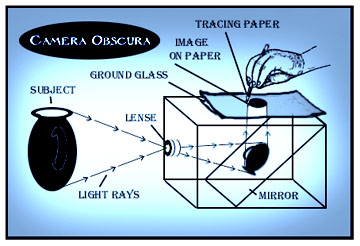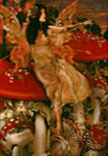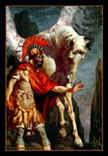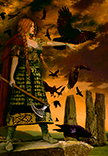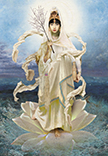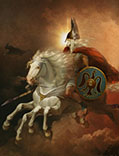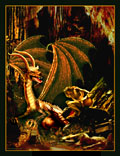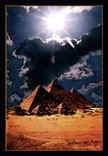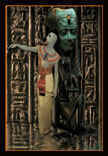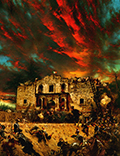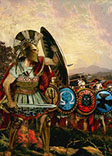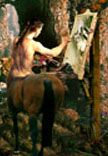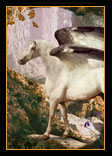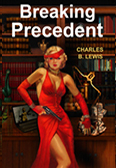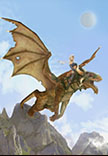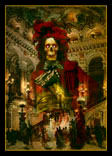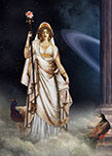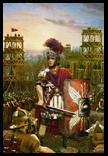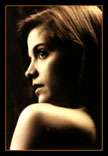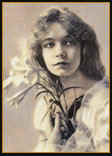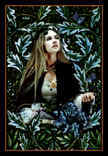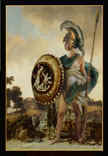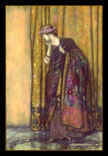|
Essay III
More Personal
Opinion Essays - on History, Myth, and Art by the artist.
HOW
DO WE SORT OUT HISTORY AND MYTHOLOGY?
"As a
professional Illustrator I am called upon to illustrate Legends of
History and Mythology, Fact and Fantasy, the Sacred and the Profane. In
as much as I have endeavored to sort them out accordingly, it has
become one of the more fascinating challenges I have ever faced."
A brief essay
by H. D. Johnson
|
As a professional Illustrator I am called upon
to illustrate Legends of History and Mythology, Fact and Fantasy, the
Sacred and the Profane. In as much as I have endeavored to sort them
out accordingly, it has become one of the more fascinating challenges I
have ever faced. As I am ever mentioning, the advances of science are
constantly giving us a clearer view of the past even causing Mythology
to become History as in the case of the Trojan Wars, the legendary
Helen of Troy, and the Trojan Horse. The archaeological excavations of
Troy may prove the existence of the city of Troy and the Trojan War.
They in no way make The Iliad a history book however, because of the
un-provable spiritual and religious occurrences in the
narrative. This sorting out of myth and legend from history is no less
difficult today because of their intertwining influences on one another.
Consider as a more recent example of this problem, 20th century
American President Theodore Roosevelt. He lives in history because of
his heroic charge up San Juan hill with his legendary roughriders. When
this story was printed in William Randolph Hearst's newspapers it
catapulted him to fame and ushered him into the White House as a
glorious American War Hero. Everyone has seen the paintings and statues
of Teddy Roosevelt and his roughriders dressed in khaki, mounted on
horseback and charging fearlessly forward waving their swords. In
reality, it was a group of Heroic African American Buffalo Soldiers who
took San Juan Hill in spite of their heavy casualties. They did not
wear khaki. They were not mounted on horseback, but were foot soldiers
in the same dark blue uniforms of the U.S. cavalry as worn during the
Indian Wars. Roosevelt's group actually took a nearby Hill against
light resistance but Hearst said that would not sell newspapers so he
created an American Myth. So as we see, here is something taught to
children in schools as history is just not true at all, but yet, this
myth shaped the true history of the world in the 20th century and
beyond.
If Teddy Roosevelt had not been elected
president, neither would his nephew, Franklin Delano Roosevelt, who
provided very real and crucial leadership during the Great Depression
and the Second World War. Neither would Theodore Roosevelt have built
the Panama Canal or established the conservation of our natural
resources. So here we see Modern Myth not only influencing, but
creating History. In reality, I perceive Theodore Roosevelt was a much
greater president than history gives him credit for. Although it is
true his kindness created the "Teddy Bear", He really was also fit and
trim, vigorous and active, and a very tough president in his foreign
policies. He was instrumental in America's emergence as a world power.
It is also true that he came from the upper upper class - old money in
New York with a background of great wealth and limitless luxury and
chose to be an outdoorsman, a cowboy, and soldier. When he was given
office, he embraced the concept of being a good Shepherd , of seeking justice
for all Americans - for this he was called a
"traitor to his class".
Actually, he is the savior of his class. In my estimation,
it is President Theodore Roosevelt who is most responsible for the end
of the then imminent threat of communist revolution or takeover in
America. Throughout the early 20th century Socialist Revolutions were
sweeping across the globe. Conditions for the workers in America were
appalling. Child Labor, dangerous working conditions, ungodly long
hours, degradation, and shockingly low pay. When Karl Marx wrote his
"Communist Manifesto" he never dreamed of an affluent MIDDLE class. A
middle class that is comfortable and savoring, life, liberty, and the
pursuit of happiness is not going to rise up in murderous anger and
"Storm the Bastille". What Global Communism could not contend with was
America's happy and prosperous middle class. Theodore Roosevelt
practically invented America's affluent middle class and eliminated the
threat of Communist revolution in America. Although he was well
loved, he was also hated and caught tremendous heat from the wealthy
elite for sharing a small portion of their wealth with the common man.
He saved them from a Second American Revolution by customizing
capitalism to a kinder, gentler form than the horrors of the late 19th
century. Like General Winfield Scott, who won The American Civil War
before it started, he defeated his foes with an idea. If the Robber
Barons had had their way, their greed could well have caused America to
fall to communism. Today, we have a new generation of robber barons but
no Teddy to stand up for the little guys. I feel the true history about
American President Theodore Roosevelt is more amazing than the myth,
but they are interwoven and inseparable, without the one, we would not
have the other. He was both a glorious and a tragic figure. As a leader
and as a man I believe he is badly underestimated. It was only when his
beloved son, nicknamed "Quinnykins" died fighting in World War One that
he finally saw through all the myths and glamour to see the awful truth
about war face on. He never got over his guilt for glorifying war to
his son. We could all learn a lot from his experiences.
War costs money...trillions of dollars. War takes human
lives...millions of them! War makes children old, breaks parent's
hearts, kills morale. War destroys cities, art treasures, civilization!
The first world war alone cost thirty million lives and 4
trillion dollars when adjusted to the buying power of modern U.S.
dollars. With the money at the time we could have built a three bedroom
two bath house furnished with fine hardwood furniture on five acres of
quality land for every family in The United States, Canada, Australia,
England, Scotland, Wales, Ireland, France, Belgium, Germany and Russia.
There would have been enough left to build and stock a first class
library and a proper university in every town of 20,000 people or more.
Out of the balance we could pay the salaries for life of 125,000
teachers and 125,000 nurses. The remaining balance could have bought
1919 Belgium and France and everything in them.
I see History as an endless waltz. Three beats over and over. War,
Peace, and Revolution. Three beats over and over in an endless cycle of
death, destruction, and regeneration. An Endless Waltz... and those who
do not learn the lessons of history are doomed to dance this deadly
waltz and pay this Frightful price for War. As modern technology such
as jet aircraft and thermonuclear missles make the world smaller &
more dangerous everyday, tolerating each other's racial, social, &
religious differences & living together in peace has now become key
to the continued survival of mankind through the 21st century...
~H D
Johnson
*****
|
Essay IV
H. D.
Johnson worked as a scientific research consultant for the University
of Texas at San Antonio through the 1970's under the guidance of top
Texas Scientists illustrating reconstructions of Paleontology and
Anthropology, oddly enough, he then worked under the guidance of the
world's foremost Biblical Scholars for the Center for Judeo-Christian
Studies. The two dramatically different experiences back to back caused
him to wonder...
Has
Science become a Religion?
a brief
essay by the artist
|
With respect
to its great contributions to society, I think it is important to make
a case that science is really affecting society more like a religion
now than a field of study or a resource base of useful information.
Many everyday people do not understand it at all and accept ALL its
teachings on faith. Science is supposed to be a tool and a path of
study for the benefit of mankind and it is. I love Science and greatly
appreciate it's benefits. I feel strongly that many scientists are
heroes and deserve honorable mention and some truly deserve places of
great honor in the hallowed halls of history. Breakthroughs in medical
science are saving lives everyday in ways undreamed of just to name
only one of so many valuable fields.
Unfortunately some scientists have also been criminals or have brought
things into the world we all know about that we would have been better
off without such as thermonuclear weapons and pollution. I believe it
has also become things it should never have become. I shall
briefly try to explain what I have seen that has made me feel that
science is really affecting society more like a religion now than a
field of study.
The
major criticism of science with regards to The Bible has
been that it requires a leap of faith to believe that GOD created the
world, yet Science also has several leaps of faith of it's own. The
Big Bang theory cannot be proven as world renowned cosmologist
Steven Hawking has stated and, if it cannot be proven - believing in it
- in Hawking's own words requires a "Leap of Faith".
Until
a theory is proven in a lab or in the field, it is Philosophy, not
Physics.
EVOLUTION IS NOT A LAW OF SCIENCE.
Darwin's Theory of Evolution
was proposed in 1859 and almost a hundred and fifty years later it has
still never achieved the status of a Law of Science.
This is because of the Missing Link. There is no proof of a link between man and ape, hence the term "The missing
link". This blind faith in Evolution has been taught with
religious dogmatism in the public schools for generations
and is still merely a theory. The Theory of
Evolution, not the Law of Evolution is a mere
UNPROVEN hypothesis, which the dictionary defines as "a
mere assumption or guess or a proposition, or a group of
proposals, offered as an explanation for the occurrence of some
specified group of phenomena."
Yet this "mere assumption or guess"
is taught to children in public schools and young adults in colleges as
if it HAD been proven beyond any doubt. It was once a Law
of Science that the atom was the
irreducible particle of matter. At Alamogordo, New Mexico in 1945 the
atom was split and the atomic bomb explosion in the desert blasted that
Law of Science out of existence.
Now, if a Law of Science is so unreliable, I ask
you, why is a mere theory like Evolution
regarded so highly? Simple. It is about political control, not about
truth.
The Missing Link
In 1912
A.D. a respectable geologist named Arthur S. Woodward and a lawyer
named Charles Dawson offered their new “fossil discovery” to the London Geological Society. The “artifacts” included a
thick portion of a human skull, a fragment of an ape-like jaw, some
animal remains and some primitive stone tools. These items found in
southern England in a place called Piltdown were estimated to be
500,000 years old.
For 40
years the remains were accepted by the academic community as an
important part of our evolutionary development. Piltdown
Man was declared genuine and called the “missing
link” between apes and man by important scientists of the time.
Because of this newfound “proof” men of God were openly ridiculed as
ignorant and improperly educated. Piltdown man was debunked four
decades later by chemical tests proving the jaw and skull were not the
same age, nor very old. It was a DELIBERATE fake.
The bones had been chemically treated and
thoroughly stained to make them appear prehistoric. Recognizable
anatomical features were broken off and filed down.
Why
did this fraud by lawyer Charles Dawson fool the experts? For many
reasons, but it was never seriously questioned because the scientists
of the time were delighted by the way it validated their evolutionist
beliefs. For more details of the debunking read: ”The Piltdown Forgery”
by J.S. Weiner, the classic account of the most famous and successful
hoax in science. The new and revised 2002 edition is commonly
available. Today, the term “Piltdown” is a term of ridicule, used to
label fraudulent research, but the impact on the lives of billions of
trusting people has had powerful political implications to this day.
The prover
proves what the thinker thinks and prejudice and
political power seem more important than the truth or the consistent
practice of the scientific method. If truth were important to them,
they would use the scientific method when criticizing The Bible
but they do not. The scientific method requires going to the source.
Yet for these famous disparagements they use the King James version
instead of the original Hebrew. Translated in 1611 by non-Christian
King James of England for political reasons the K.J.V. is one of the
Colossal monuments of English Prose. The King James Translation is not
at all accurate enough to use as the sole source for the defense of the
Biblical Text.
Consider this example: One of the greatest conflicts between Science
and the Bible is the teaching that the world was created in six solar
days of 24 hours each. The word " yom" in the source, the
original Hebrew text, which was translated as "Solar Day" had 56 other
choices. Modern English has more than 60,000 words. Biblical Hebrew had
3,000. The average English vocabulary has 6,000. My favorite choice of
the 56 other options:" an unimaginably long but complete period of
time" harmonizes with science perfectly. Another choice is: "time
itself". So as we can see, going to the source and using the Scientific
Method brings very different results than not going to the
source.
Getting past this, the order in which life appeared was identical to
the theory of evolution's claims in the Book of Genesis, leaving us to
discuss the stars, the next main source of conflict between Science and
the Bible. The Hebrew text says "a swaddling band around the Earth
dissolved, revealing the stars. The Prover proves what the thinker
thinks. Here's a fun thought - What if GOD is in control of evolution?
What if it's his hobby? What if there is really no conflict between
Science and Religion? The scientists cannot disprove the existence of
GOD any more than they can prove the Big Bang happened.
Albert Einstein saw no conflict between science and religion. Like
Galileo, Newton and other immortal greats of science before him,
Einstein believed in GOD.
Therefore, I present to you this idea: Modern Scientific beliefs are
based upon a leap of faith in the big bang theory. It has become a
belief system based on faith and therefore another form of
religion. Scientists, like priests can explain their beliefs but
the everyday people accept it all on faith. Scientists and doctors are
the priests of this new religion, getting angry and crying "heresy"
when anyone respectfully disagrees with them. I once had one of my
supervisors in the UT anthropology department explain to me for three
hours on a research expedition in mathematical terms how something
could have ALWAYS existed, needing no beginning point. When we agreed
that the math was good he then made a COLOSSAL leap of faith, saying
"This proves the Universe has always existed and there is no GOD." In
one second I countered;" I could just as easily jump to the conclusion
that this proves the existence of an eternal GOD." It is this "jumping
to conclusions" or as Steven Hawking put it; "making leaps of
faith." that infuses philosophy with their physics. Then there is
the infusion of politics; a perfect example is
The
Myth of Carbon 14 dating:
Educated people know that carbon 14 dating is totally
irrelevant to the theory of evolution. Scientists never state that
carbon 14 dating offers proof for the theory of evolution. Ignorant
evolutionists, however, believe carbon 14 dating proves the theory of
evolution, and stubbornly make that claim based on faith in what they
were told in our learning institutions. They were DELIBERATELY lied to to gain
POLITICAL POWER. I will explain; Carbon 14 dating is ONLY reliable for
five thousand years as even its creator himself admitted in 1972.
Carbon 14 or Radiocarbon Dating was first
devised in 1949 by Dr. Willard Libby. It is based on the rate of decay
of carbon 14 or its "half-life" of 5730 years. This method offers
reliable dates up to 5,000 years ago, but its results require
correction since Dr. Libby's belief that the levels of carbon-14 in the
atmosphere were identical through the ages has long since been
disproved. Volcanoes and floods for example skew the results to the
point where guesswork or leaps of faith are required even in dating
organic material from historic times. Dr.
Libby once expressed his shock when he found that radio carbon dates
for human artifacts extended back only 5000 years and older dates were
found to be unreliable. [W.F.Libby,
`Radiocarbon Dating', (Chicago, 1952), pp. 4-9] [CRSQ, 1972, 9:3, p. 157]
By this
time tens of thousands of C-14 dates had been published from tests in
laboratories around the world. The textbooks and curriculums have yet
to be revised. Instead, a MYTH is being taught in our schools.
There are exciting new methods but wild guesses about the amount of
Carbon 14 in the atmosphere do not PROVE anything. Believers in GOD are
called foolish and ignorant on the political strength of this
deliberate lie that Carbon 14 dating proves evolution.
The gross disrespect and intolerance I have seen of certain members of
the scientific and academic communities and their disciples toward anyone
who disagrees with them is just as arrogant and abusive as racial,
sexual, religious, or any other kind of prejudice.
Here's a
great example: Around 1910 in educated circles it was considered a mark
of ignorance to believe the Biblical record. There was little
scientific evidence available then to support the Bible's claims and
academic circles decided that was the end of the matter and as the
decades moved on, the scientific and academic communities stubbornly
ignored tidal waves of new SCIENTIFIC evidence. One excellent
example is in what the Bible says about Abraham. In the early
20th century experts in the field of archaeology insisted that no
civilization even existed in UR of the Chaldeans when the Bible records
that Abraham lived there. On the basis that no evidence was currently
available they declared Abraham a mythical character.
20th century evidence however has proven beyond any question the
existence of an advanced civilization in UR of the Chaldeans during the
21st and 20th centuries B.C.-That was Abraham's day! Abraham's
historicity is also confirmed by ancient inscriptions that bear the
names of almost very town mentioned in Ch. 12-14 of Genesis and one
even has his father's name. Archeological discoveries also show these
towns were in existence until about 2,000 B.C.- but not later!
No longer
can the Bible's critics get away with accusing us of being naive or
foolish today when we believe what the Bible says about Abraham like
they used to in the 20th century.
This is
critical to the belief systems of the world's great monotheistic
religions Islam, Judaism and Christianity who all claim ascendancy from
Abraham. Why isn't this commonly taught in schools? Many scientific
professionals openly abuse the authority of their positions to push
their personal beliefs and ignore the confirmed scientific
data to hold on to political power. Other Biblical confirmations
from modern Archaeology include: Date and manner of Jericho's fall, The
exodus from Egypt, Major characters from the book of Daniel and many
others. The SCIENTIFIC proof is all there waiting for you if you take
the time to look it up.
Certain scientists and academics like to act like they
know everything about the origins of the Earth. They don't. Many of our
long taught ideas about planetary science have recently been proven
completely wrong. Did you know that The Gas Giants on the outside of
our solar system and the surface of the Planet Venus are DRASTICALLY
different than what I was authoritatively taught about them as a boy in
school? If
they can't even tell us reliably how the solar system is today how can
we rely on their ideas about its distant unobservable origins? Yet
even in the face of constantly changing SCIENTIFIC evidence most
scientists are prone to UTTER DOGMATISM about their belief system.
Science is supposed to be the
sum of the best knowledge we have at the time - incomplete but always
learning, always growing- but sometimes making serious mistakes. Why
admit things were COMPLETELY wrong about planetary science within the
solar system but NEVER MENTION the discovery
of the unreliability of Carbon 14 dating or the discovery of archaeological evidence of
Abraham being a historical figure? Simple. There is no danger to the
foundation of the belief system of this new religion or it's social and
political power base.
Mankind's only hope for continued survival
on this planet is to learn to tolerate each others differences and live
in peace with one another and in harmony with the environment. We're
all in the same boat...
I do not believe that scientists should be exempt from this challenge
to be tolerant, since they created the very things that could
well destroy us, such as thermonuclear weapons & pollution.
We all
have a lot of work to do if we are to survive. I write this in defense
of my faith and of the faiths of others which have been disparaged by
these attacks on the sacred writings of the world's great
religions...If we're going to have a better world we're going to need
both better leaders and better citizens.
I
personally believe that any belief in a higher power that must
be answered to makes us better citizens than if we believed that we are
the ultimate life form in the Universe.
~ H D Johnson
|
Essay V
Sensuality,
Violence, Morality, and their relationships with the Arts in 21st
century American Society
A case for
the sacredness, purity, and beauty of the human form
A brief
personal opinion essay by the artist
|
In
our 21st century western society the disparity between the moral
attitudes toward images and actions is amazing to me and I will examine
in this
article just how unfair they really have become and how "political
correctness" is destroying our cultural heritage.
In history,
the Classical or Greco-Roman school of art is distinguished by the
notion that the human
form is the ultimate arena for artistic expression. Unclothed figures
were very common in
Classical art and their culture was very comfortable with it in
general. The Victorians in
contrast have always stood out in my mind for their extreme prudishness
and
puritanicalism. They invented the tablecloth to prevent men from
looking at a table's legs
because they feared a table leg might make men think "dirty thoughts".
In spite of this, 19th
century Victorian Art did allow some unclothed figures in statues and
paintings within
certain bounds. One of the principal attractions of fairy paintings for
the Mid-Victorians
was that they made possible highly realistic and erotic pictures of
unclad females that
would have otherwise been inadmissible. In the 20th century the sensual
revolution
eliminated all of these traditional boundaries. I can see how the
radical transformation
of society by the total liberation of the subconscious was a bit too
much for most people.
In 21st century America however, the sight of a healthy partially
unclad woman is taboo even
as an innocent or religious depiction in the
visual arts.
A moral
pendulum swinging too far
again?
I find this very interesting considering they way American
society is so
comfortable with violence- even children viewing extreme violence and
gore on television and in motion
pictures. It's terrible- disembowelments, exploding heads with
splattering blood and guts,
cut off arms and legs are deemed just fine for prime time children's
viewing. But not to
worry- the profanity has been edited out. It seems too arbitrary to me.
If the human body
is torn apart or cut to pieces it is all right. Desecration of the
human body is embraced
or tolerated while appreciation or adoration even in art, is condemned.
I
think the human form is sacred.
The average
American child sees
20,000 violent deaths on television alone by the age of 10.
I find it interesting that America feels that while
tolerating and even
embracing extreme violence and greed that we are outraged at the sight
of a
beautiful young woman and the healthy uncovered female human body is a
dirty,
filthy thing to be ashamed of. I disagree.
Since the source for this stigma
about images of
women is supposed to be the influence on our society's laws by the
sacred
writings of the Judeo-Christians, I present to you the idea that this
is not
what these actually teach and they are also being treated as
arbitrarily as a
buffet line and will use illustrations. This attitude comes
from Jesus' saying: "If a man even look at a woman
to lust after her, he has already committed adultery in his heart." By
this same
standard, just thinking about robbing the poor and the elderly is a
sin, but in our
society the act is considered "a good business move". Don't
misunderstand me, he
taught that his commandment was to love one another, and basically that
if you did that
the ceremonial law was fulfilled. A more positive approach; if you love
someone you won't
murder them, falsely accuse them, etc., etc., If your heart is full of
covetousness for a
woman, a car or anything it is likely you will transgress this law in
practice. Cheating,
stealing, torture, and even murder in actual practice are taken in
stride by our society, but
seeing a woman's left bosom exposed is an outrage. If the Ten
Commandments are the
standard we're going by as they say-
What about
the other nine?
Children are diligently taught to dishonor their parents
on
every "family" television show. It is taboo now- yes, it is actually
considered
wrong to portray a good father in American movies and television with
only the rarest of
exceptions. What is so terribly wrong about a portrayal of a good dad?
To me, this is an
outrage. Stealing the retirements of thousands of citizens who have
worked hard all their
lives is "a good business move".
What about
"thou shalt not murder"?
(Interestingly, it doesn't say” kill"{ harag } in the original Hebrew
text, {
Exodus 20:13 } but "murder"{ ratsach }. ) I won't dwell on war here,
but In Nazi Germany, six million people-
Jews, Christians, and politicals were secretly murdered in the death
camps, but in modern
America, more than forty million baby boys and girls have been publicly
murdered
by willing citizens in
abortion clinics and we call that a “choice". If history called that
the
Holocaust,
how will history judge us? Judeo-Christian morality, and
that's what we're talking about here as the most influential source of
America's
laws, ONLY justifies killing in self-defense. The child in the womb is
defenseless.
Again,
I find this astonishing that we
as a society can tolerate or even embrace such horrific and gruesome
acts and then make
such a big issue out of mild nudity in a painting or statue. Our
society treats
sacred writings like a buffet line choosing what is politically
expedient to
their cause and ignoring the rest.
I ONLY
bring these up as an examples of the disparity between society's
acceptance
or tolerance of these violent and gruesome things
I've mentioned to contrast them to the intolerance of the sight of
a peaceful woman’s uncovered bosom celebrated for it's natural beauty
in an
innocent setting through the visual arts.
Why is the
sight of a naked
man's chest considered to be decent and not a woman's? I think there is
a
disparity here too in our attitude toward images. If the sight of a
woman's chest is an
outrage why is a man's permissible in ANY situation? I am
told certain works of Leonardo Da Vinci are pornographic now because of
a nipple
but I see romance novel
covers in the grocery store with photos of naked men climbing in
bedroom windows
to commit adultery-why are those considered acceptable? If
images are wrong because there is a chance a man might think of sex,
why are
"romance" novels written glorifying vile acts of sexual betrayal for
NO OTHER REASON but dirty thoughts acceptable? Why are sleazy soap
operas on television
available to children day and night on broadcast television with
sexually explicit scenes glorifying adultery acceptable?
The answer is
simple- its double standard.
As a man, I believe that women are the brightest and
loveliest of all of GOD's creations. The
sight of a healthy young partially uncovered girl on television even
for a split second is
considered a CRISIS and we hear public outrage? Implying the human body
itself
is filthy; Think about
it. Since the basis of this sight of a healthy human body taboo is
supposed to be of
Judeo-Christian religious origin, I want to debunk this outrageous
doctrine that the
human body is filthy. In the Bible's first book, Genesis, it says,
"they were naked
and were not ashamed" and it teaches us that men and women were "made
in the
image of GOD". To follow this line of reasoning, GOD would also have to
be filthy.
Case closed. I don't think what I perceive to be the crowning
achievement of GOD's
creation, the woman - is filthy, but is instead pure and beautiful.
What I
believe to be GOD's greatest
creation is considered filthy, and not people's minds?
What's wrong
with this
picture?
These outrageous boundaries
chosen by our society are
so poorly thought out that Michelangelo's statue of David is now deemed
pornography and
books with such immortal works of art are being removed from our public
school
libraries because of "politically correct" activists. I'm not
suggesting that we remove these boundaries again like in the 1970's,
Heaven forbid! Only that these newest ones
are ill conceived and badly placed and I would personally prefer to
return to the
traditional ones and avoid all these extremes.
~ HD
Johnson
*****
|
Essay VI
Copyright
Law and the Visual Arts in the Computer Age
An
introduction to the Millennial Copyright Act for Artists
A brief essay
on 21st century legal boundaries, guidelines, and western art
traditions by the artist
"Our
shared cultural heritage, great works of art, literature, music and
drama, cinema, folk
tales and fairy tales are all drawn upon again and again by the
creators of new works.
These works in the public domain are both a catalyst and a wellspring
for creativity and
innovation. Since the public domain is a treasure trove of
information and resources to be used by
future generations, many advocates are concerned that its stagnation
through lawsuits will make it more and
more difficult for future generations to find creative inspiration."
|
"All
art is
ultimately some form of imitation, even if you are an expressionist
painter imitating an
abstract vision in your own mind. These new visual art creations of
mine take their
inspiration in part from the realistic paintings of the old masters
just as The Lord of
the Rings comes from The Ring of the Nibelung and European folklore and
West Side Story
came from Romeo and Juliet, which was in turn inspired by Antony and
Cleopatra. Much as
Rubens copied Titian, I copy Waterhouse and so on. Over the
last 300 years,
ideas about female beauty have drastically changed and this has caused
many of the most
wonderful paintings of the old masters to seem 'ugly' to youthful
modern audiences. For
example, in the days of Peter Paul Rubens, being forty to sixty pounds
over-weight was
considered not only attractive, but was a status symbol. Beauty is in
the eye of the
beholder and tastes have clearly changed. I feel
many classic themes
need to be redone to preserve interest and appeal for future
generations. This has
happened many times before as artists like Aesop, The Brothers Grimm
and Walt Disney have
appropriated, modified, and re-defined elements of our culture to
preserve it for future
generations. The legality of such use today depends on whether or not
the source is
protected by copyright law. You can draw or paint Shakespeare's fairies
for example and
publish them without permission but not more modern intellectual
properties like
characters from Star Wars or Mickey Mouse who holds the oldest
copyright dating from 1928.
Our
shared cultural heritage, great works of art, literature, music and
drama, cinema, folk
tales and fairy tales are all drawn upon again and again by the
creators of new works.
These works in the public domain are both a catalyst and a wellspring
for creativity and
innovation. Even though all my Realistic Paintings are
legally new works and
protected under copyright law their inspiration sometimes comes in part
from works in the
public domain.
The
public domain is a space where intellectual property protection (
copyright ) does not
apply. When copyrights and patents expire, innovations and creative
works fall into the
public domain. They may then be used by anyone without permission and
without the payment
of a licensing fee. My
sources have been transformed so much in the creation of these new
works of art that they
would not violate an existing copyright even if they were so protected. Publicly owned national parks are
also considered by many
to be public domain lands. Because of the recent extensions of the
terms of both
copyrights and patents, and the privatization of lands and other
resources owned by the
Federal Government, little is now entering the public domain. Look for
new litigation and
another time extension when Disney Corporation's Mickey Mouse copyright
is due to expire
in 2023. Where would Walt Disney be without the Brothers Grimm, Hans
Christian Anderson,
or Victor Hugo? Where would Aaron Copeland have been without American
folk music? Thomas
Nast's Santa Claus without traditional images of Father Christmas?
Picasso without African
art? These are artists who made names for themselves and even fortunes
through Public
Domain appropriation, one and all.
Some people are
actually outraged that there are some intellectual properties that
corporations do not
own. They feel appropriation is only appropriate if a corporation does
it. Corporations
created by public domain appropriation, now are the most powerful force
on Earth trying to
put a stop to new things entering the public domain forever through
lawsuits. The public
domain is a space where intellectual property protection ( copyright )
does not apply. It
was set up by our founding fathers, who felt creativity needed to be
rewarded on a
personal level for a time, and when copyrights and patents expired,
innovations and
creative works would fall into the public domain.
Since the public domain is a treasure trove of information and
resources to be used by
future generations, many advocates are concerned that its stagnation
will make it more and
more difficult for future generations to find creative inspiration.
This is least likely to hurt the
motion picture companies who produce new works
"in house" granting themselves permission, but the music industry which
brings in artists and new songs from the outside
is being hit very hard already. If a new song release resembles an old
one, now there is
litigation. Visual Art
Tradition and
etiquette suggest the most influential
pieced borrowed
from the public domain should be mentioned at exhibits; these original
new
pieces Shown in my exhibits take their inspiration in part from the
paintings of
Waterhouse, Alma-Tadema, Moreau, Bouguereau, Leighton, Ingres, Moore,
Parrish, Rackham and
others. They showcase some of my favorite models. As a student of
fine art, copying
is a great way to learn and create fine art, but as a professional
illustrator things are
very different. Works done by artists out of personal motivation belong
to the artist who
created them, and they can sell licenses for divers forms of
publication. The law is clear
and simple regarding illustrations done for gainful employment. They
are called
"work-for-hire" under the law, and the rights to such works envisioned
by the
customer and specifically commissioned and paid for belong exclusively
to the customer
if it is a team project like a video game or motion picture and
the artist must specifically ask permission to ever legally use their
own work themselves.
When the artist is the sole creator of the project as in book and
magazine
illustration for example, the artist retains the benefits of ownership
unless
they specifically sign them away.
My art is
divided into two distinct groups; personal work partially copying the
old masters and
professional illustration applying these lessons to create totally
original works. I start
more often with a specific written request. This is the exact OPPOSITE
approach to
creating a picture from copying something that's there.
Research
comes first. In the case of my illustration of the Spartan Warriors,
there were no
accurate sources in the public domain to copy correct Greek armor and
weapons in combat
poses from. Mostly I found images of effeminate men, wearing
nothing but a robe over
the shoulder and the wrong helmets. Finding history books at the
library with the accurate
helmets, shield designs, weapons, and armor was essential to get an
accurate depiction of
a Greek Hoplite. All the library had were stiff museum poses of
anything, but I hit
the research jackpot with some very simplistic flat line drawings of
great authentic Greek
shield designs.
All the
elements must be found, gathered and assembled to create the dramatic
action scene the
client wanted. Next comes the layout. This is where the mathematics and
geometric design
come into the creative process. My wife, Virginia took a picture of me
nearly twenty years
ago on a carpentry project with the heroic Jack Kirby like pose I was
looking for mixed
with the texture and feel of a Frank Frazetta or Norman Rockwell
painting. Naturally, in
these cases I go to great lengths to make sure that my work looks
nothing whatsoever like
it's various inspirations and sources except in flavor and spirit. Of
course, the
characteristic old master's painting feel to the background most of my
illustrations have
was requested, and the picture was to have the flavor of a Howard Pyle
painting.
With regards to use of mechanical aids to create art: Did you know the
old masters often traced? Leonardo Da Vinci used "Camera Obscura"
which is a lens and a mirror set at an angle with parchment over
it to trace onto. Michelangelo used a similar technique. The use of Photography as a mechanical aid to
oil paintings and other forms of realistic art came right away. This is
not surprising since artists had been tracing from Camera Obscura for
thousands of years. Famous Myths; Leonardo Da Vinci (1452- 1519 ) is
often credited with the invention of Camera Obscura because he used it
for his masterworks during the Renaissance and mentioned it in his
notebooks, but this is simply not true. Similarly, Americans are
credited with the camera, but it is also not true. Unlike the camera,
the inventor and time of invention of Camera Obscura are unknown.
Perhaps a crude form of it was known to the ancient Greeks, but there
is no evidence for this. The mathematical precision and perfect anatomy
of Greek art combined with their passionate love of science and
mathematics is enough for many scholars. The earliest description of
Camera Obscura occurs in the great optical treatise of the Islamic
scientist Al-Hazen who died at Cairo, Egypt in A.D. 1098. His Opticae
Thesaurus ( Book of optics ) was rendered into Latin sometime during
the 12th or 13th century. Al- Hazen honestly declares that he himself
did not discover it, so we know it had to have come earlier. Think that makes it too
quick and easy? You'll find once you've finally got that
outline done right you're a long, long, way from being finished in any
medium... if these
men who set the standard for realistic excellence used them, why
shouldn't those who come
after them be permitted? Simple, because this is one of the most
carefully guarded
"secrets of the old masters" and most people don't know very much about
art
history...
When asked
why I usually work from photos I like to re-tell Norman Rockwell's
story about having to
paint a chicken: He set it up on a stump in a barn and goes to
painting. The chicken moves
it's head. He moves it back. The chicken jumps down. He puts it back.
He goes to paint.
now the chicken decides to make a break for it... he chases it down
clucking and screaming
and puts it back. Now it knows he's going to have it for dinner and it
goes completely
berserk. The next day, he came in and set the chicken back, snapped
it's picture,
and the
photo held nice and still."
I have built up an enormous library of original 35 mm source photos for
use in my
realistic art. For decades I have been seeking out the most
beautiful models and
sometimes even their boyfriends and relatives, bringing them in for
sessions into my photography studio. The
law with regards to copy rights on analog photographs was simple - if
you owned the negative you owned the
rights. This new instant copyright without filing law is very nice for
photographers and artists working with their own photos, but not so
good for
free-hand drawings from the imagination and other non-photographic
based forms
of drawing and painting like cartoons.
This is the main reason I use my own photographs.
Using a strategy employed by J. W. Waterhouse, my wistful and graceful
female models cannot
be underestimated in their contribution to the stunning beauty and the
potential for
lasting appeal of my work. I am always make sure to both overpay them
for their time and
also the rights. I always get a written contract with the exception of
my dearest friends
and closest family who are always making cameo appearances. The models
get amenities and
services including portraits, portfolio photo sessions, photographic
reprints and
enlargements, leather presentation cases, webmaster services, original
art, and reprints
of their appearances in my drawings and paintings as well as above
scale cash payments at
the time of the shoot.
With regards to using
copyrighted material as a reference- When you have to paint a
wombat you can't fake
it- you need a picture! The law understands this and automatically
grants provision -
within reasonable limits; when using copyrighted sources the source
image
must be so transformed in overall appearance in the translation as not
to be
what the law calls "confusingly similar"...
If it's newer than 1928 you can bet it's probably copyrighted - they
had to renew exactly
26 years later in those days or it would pass into the public domain,
so it might not be
copyrighted if it wasn't a big moneymaker. Always be sure to check in
these cases. If it's
newer than 1999 under the millennial copyright
act the law says it is automatically
copyrighted without even filing. However, this new law is very tricky
in it's wording
because you must have already have filed with the copyright office in
advance if you ever
need to take legal action. They say it is copyrighted, but you
cannot sue
if it is not registered with the United States Library of Congress
Office of
Copyright. Because of this "instant copyright without
filing" clause, there is a serious danger of artists being made legally
helpless and left open to being cheated out of their
work.
From
an artist's standpoint, this is a huge improvement over the original 14
year
copyright term. When properly interpreted and acted upon, by filing
works with
the United States Library of Congress Office of Copyright, these laws
are GREAT for contemporary artists
and their estates, who will hold rights for seventy years after the
artist's death."
~ Howard David Johnson
*****
The Constitutional
Provision Respecting
Copyright
The Congress shall
have power... To promote
the progress of Science and the useful arts, by securing for limited
times
to Authors and Inventors the exclusive right to their respective
Writings and Discoveries.
United States
Constitution Article I Section 8
( This essay is not
meant to take the place of
expert legal council, but to introduce people to the basic concepts. )
|
Essay VII
On Art and Technology: When Seeing is Not
Believing
An essay dealing with mechanical aids
to visual art from Camera Obscura to Computers
|
|

